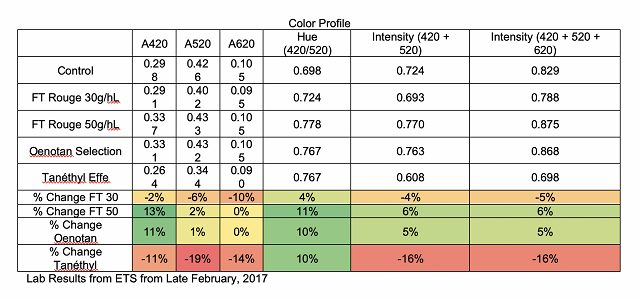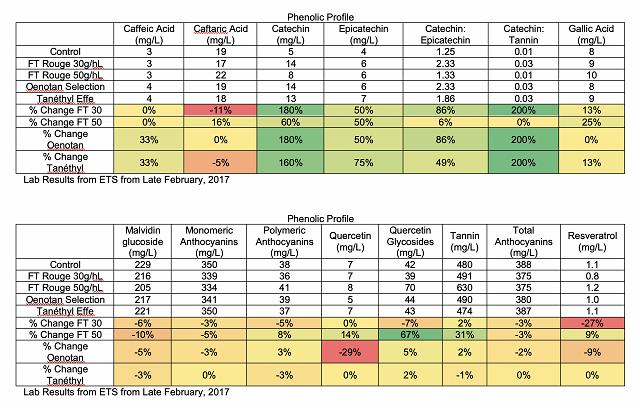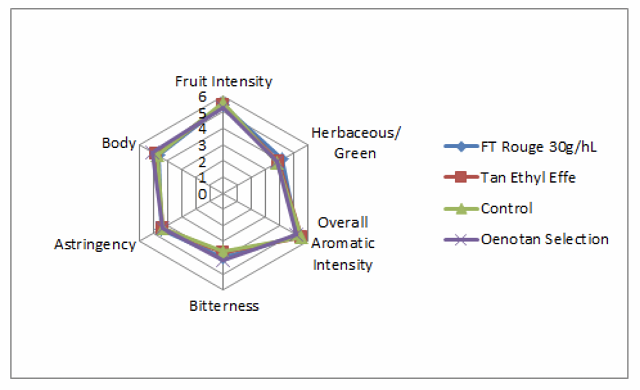Effects of Adding Hydrolyzable vs Condensed Tannin during Red Wine Fermentation (2016)
Theo Smith
Rappahannock Cellars
Summary
This study examines the impact of adding different sources of exogenous tannin to fermenters during Merlot processing. The treatments were set up as follows: 1) Control, 2) FT Rouge (ScottLabs) at 30g/hL, 3) FT Rouge (ScottLabs) at 50g/hL, 4) Tanéthyl Effe (AEB) at 10g/hL, and 5) Oenotan Selection (Esvin) at 10g/hL. All treatments were the same, except that the treatment with FT Rouge at 50g/hL was inoculated with a different yeast from the rest. This wine was therefore not tasted at sensory sessions. No major wine differences could be seen between treatments. The tannin varied with their effect on color intensity: some increased intensity slightly whereas others slightly decreased it. Anthocyanin, in general, was slightly lowered by tannin addition. Tannin content was relatively unaffected, except for FT Rouge 50, which experienced a large increase in tannin. The differences from FT Rouge 50, however, may have been due to the yeast strain used, and does not indicate necessarily that the increase in tannin addition had the effects. Overall, no major preferences could be seen for any treatment, except that the Tan Ethyl Effe was often least preferred. There may have been large changes in wine sensory qualities in bottle over time, as the wines seemed to taste different at the different tastings. This could confound any attempt to compare wines across tastings. This study suggests that exogenous tannin can have impacts on final wine chemistry and sensory qualities, and this may be largely impacted by yeast strain selection as well. In the future, more studies examining the combined impact of exogenous tannin addition with yeast strain selection should be performed.
Introduction
Often oak chips, enological tannin, or even skins from other grapes are added to must prior to the onset of fermentation. It is thought that these additions may help prevent oxidation, enhance color stability, and enhance phenolic quality and mouthfeel. They may also ameliorate tannin problems from unripe or damaged fruit, increase the amount of tannin available to form polymeric pigment, and reduce vegetal aroma (Zoecklein 2005). Some authors have observed that exogenous tannin can both enhance the final concentration of anythocyanin in wine after 72 hours of fermentation (Giacosa et al. 2017). It is not clear from this study how stable this difference in wine is over time. These effects all depend on the source and kind of tannin (hydrolysable vs condensed tannin). All grape-derived tannin is condensed tannin, whereas hydrolysable tannin comes from oak wood or additives (Zoecklein 2005).
The timing of tannin addition will greatly impact the effect of these tannins, with earlier additions having less of an impact. Although pre-fermentation additions may help the exogenous tannin to integrate more fully with grape phenolics to form polymeric pigment, yeast cell walls will often bind tannin during precipitation, thus in effect “fining” tannin out of wine (Zoecklein 2000; Zoecklein 2005). Additionally, sometimes tannin addition can result in protein precipitation in must, causing a cascade of tannin precipitation which could actually result in lower tannin concentration in the finished wine (Steve Price, 2017, personal communication). This study examines the impact of different tannin sources on the chemical and sensory characteristics of wine. Questions about yeast strain impact on these qualities were also raised, but not answered, in this study.
Results and Discussion
No major wine differences could be seen between treatments. The tannin varied with their effect on color intensity: some increased intensity slightly whereas others slightly decreased it. The color increase is likely due to the slight increase in polymeric anthocyanins for the FT 50 and Oenotan wines. Catechins were slightly increased by tannin addition. Anthocyanin, in general, was slightly lowered by tannin addition. Tannin content was relatively unaffected, except for FT 50, which experienced a large increase in tannin. The differences from FT 50, however, may have been due to the yeast strain used.



No strong trends were found with the descriptors used in this study on the April 26 tasting. In general, people preferred the Control wine. The least preferred was Tan Ethyl Effe. But these preferences were not very strong.


For the May 24 tasting, there was a strong trend for the Oenotan wine to have higher Fruit Intensity than the other wines. No other trends are apparent between treatments. No preference trends are noticeable except that Tan ethyl Effe was often less preferred. One judge had no preference.


Overall, no major preferences could be seen for any treatment, except that the Tan Ethyl Effe was often least preferred. There may have been large changes in wine sensory qualities in bottle over time, as the wines seemed to taste different at the different tastings. This could confound any attempt to compare wines across tastings. More studies should be performed on these exogenous tannin sources to help elucidate their effect on wine, both immediately and over time. Additionally, the phenolic differences in the FT Rouge 50 treatment suggest that yeast selection may have a large impact on phenolic characteristics of the wine, and more studies which examine this yeast impact should also be performed.
Methods
On 9/13, Merlot was harvested from the Kennridge Vineyard, destemmed (not crushed), and separated into 5 bins. The trial bins were set up as follows:
- Bin 1: Control – no tannin addition, 2600 pounds must, 836L
- Bin 2: FT Rouge at 30g/hL (blend of hydrolysable-untoasted oak and chestnut, and condensed tannin – grape skins and seeds) , 2300 pounds must, 740L
- Bin 3: Tan Ethyl Effe at 10g/hL (condensed tannin from grape seeds), 2600 pounds must, 836L
- Bin 4: Oenotan Selection at 10g/hL (untoasted hydrolysable tannin from French oak) 2400 pounds must, 772L
- Bin 5: FT Rouge at 50g/hL, 2350 pounds must , 757L
Bins 1-4 were prepared on 9/13 and inoculated with 25g/hL D254 rehydrated with 30g/hL GoFerm. Bin 5 was added later to the study, and although was sourced from the same fruit was not inoculated until 9/14 with a different yeast (25g/hL D80 rehydrated with 30g/hL GoFerm). Must was punched down once per day until fermentation became vigorous (around 48 hours), then twice daily during vigorous fermentation. At around 5-7 Brix, punchdowns were once daily again. On 9/18 all fermentations were inoculated with 1g/hL lactic acid bacteria (Oenococcus oeni Beta Co-inoc). All fermentations were drained pressed on 9/20 into flex tank eggs but only free run was used. By 10/4 all fermentations were dry and had completed malolactic conversion, and were stabilized with 60ppm sulfur dioxide. On 10/20 each wine was racked to a total of 16 neutral oak French barrels.
This project was tasted on April 26 and May 24. In order to balance the data set to perform statistical analysis for descriptive analysis on the April 26 tasting, any judge who had not fully completed the descriptive analysis ratings were removed. In order to then make the amount of judges between groups equivalent, one judge from group 2 was transferred to group 3, and another judge from group 1 was eliminated. This resulted in a final data set of 3 groups, each with 6 judges (considered as replications within groups, and groups were considered as assessors). Data was analyzed using Panel Check V1.4.2. Because this is not a truly statistical set-up, any results which are found to be statistically significant (p<0.05) will be denoted as a “strong trend” or a “strong tendency,” as opposed to general trends or tendencies. The statistical significance here will ignore any other significant effects or interactions which may confound the results (such as a statistically significant interaction of Judge x Wine confounding a significant result from Wine alone). The descriptors used in this study were Fruit Intensity, Herbaceous/Green, Overall Aromatic Intensity, Bitterness, Astringency, and Body.
The same procedures for data analysis were used on the May 24 tasting. For the descriptive analysis in this tasting, one judge had to be removed from group 2 and group 3 to balance the data set. This resulted in a final data set where each group had four judges, for a total of 12 judges.
References
Giacosa, S., Segade, S.R., Rolle, L., and Gerbi, V. 2017. Study of the role of exogenous tannins in color preservation during the early stages of maceration. Universitá degli studi di torino.
Steve Price, Personal Communication, 2017.
Zoecklein, B. 2000. Wine structural development. Enology Noes #8. http://www.apps.fst.vt.edu/extension/enology/EN/8.html.
Zoecklein, B. 2005. Enological tannins. Enology Notes #103. http://www.apps.fst.vt.edu/extension/enology/EN/103.html.
